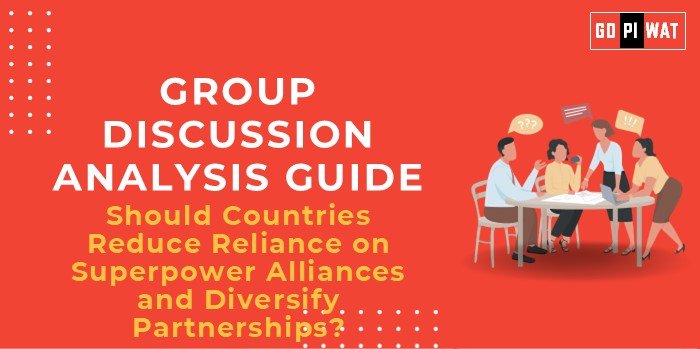📋 Group Discussion Analysis Guide: Should Countries Reduce Reliance on Superpower Alliances and Diversify Partnerships?
🌐 Introduction to the Topic
- 📌 Opening Context: The global geopolitical landscape is increasingly complex, characterized by shifting alliances, economic interdependence, and the rise of emerging powers. For countries, reliance on traditional superpower alliances may seem strategically secure but could limit autonomy in a multipolar world.
- 📖 Topic Background: Historically, superpower alliances dominated global politics during the Cold War and its aftermath. However, the 21st century has seen a diversification of power centers with emerging economies like India, Brazil, and regional blocs asserting influence. This raises a critical question: should countries balance their alliances by engaging more broadly?
📊 Quick Facts and Key Statistics
🌍 Global Trade Interdependence: 60%+ of global trade involves nations outside traditional superpower control (WTO, 2023).
🌐 China’s Belt and Road Initiative (BRI): Spanning 140 countries, it shows the rise of alternate partnerships.
💡 Russia’s Influence in Energy: Supplies 40% of Europe’s natural gas, emphasizing interdependence despite alliances.
📉 G7 vs. BRICS: G7 GDP share declining, from 46% (2000) to 31% (2023); BRICS growing at 27% GDP share.
🌐 China’s Belt and Road Initiative (BRI): Spanning 140 countries, it shows the rise of alternate partnerships.
💡 Russia’s Influence in Energy: Supplies 40% of Europe’s natural gas, emphasizing interdependence despite alliances.
📉 G7 vs. BRICS: G7 GDP share declining, from 46% (2000) to 31% (2023); BRICS growing at 27% GDP share.
👥 Stakeholders and Their Roles
- 🏛️ Governments: Shape foreign policy to balance traditional alliances with regional and global partnerships.
- 🌍 Regional Blocs (e.g., ASEAN, AU): Act as mediators for shared economic and political goals.
- 📌 Multilateral Institutions (e.g., UN, WTO): Provide platforms for non-aligned collaboration.
- 💼 Private Sector: Push for diversified trade to mitigate geopolitical risks.
🏆 Achievements and Challenges
✨ Achievements:
- 💪 Economic Resilience: India’s diversified partnerships, such as the Quad and BRICS, enhance its global influence.
- 🌏 Regional Strengths: ASEAN has shown how collective bargaining reduces over-reliance on superpowers.
- 🔗 Reduced Military Dependence: Europe’s PESCO framework increases EU autonomy from NATO.
⚠️ Challenges:
- 📉 Economic Dependency: Heavy reliance on US/China affects trade balance and decision-making autonomy.
- ⚔️ Security Concerns: Reduced reliance might lead to weakened military support (e.g., Taiwan-US tensions).
- 🌍 Global Disparities: Smaller nations may lack bargaining power compared to superpowers.
🌍 Global Comparisons:
- ✔️ Success: Finland’s non-alignment policy until NATO accession proved effective for neutrality.
- ❌ Challenge: Venezuela’s attempt to diversify led to economic crises due to poor planning.
Case Studies:
- 🇮🇳 India: Balancing ties with the US and Russia while engaging with Africa and ASEAN.
- 🇸🇬 Singapore: A hub for diverse partnerships, balancing Western and Asian influences.
📢 Structured Arguments for Discussion
- ✅ Supporting Stance: “Diversified partnerships empower nations to secure economic stability and political autonomy in a multipolar world.”
- ❌ Opposing Stance: “Superpower alliances provide critical security guarantees that smaller or medium-sized nations cannot replicate alone.”
- ⚖️ Balanced Perspective: “While superpower alliances ensure strategic security, diversification is vital for economic resilience and global engagement.”
🧠 Effective Discussion Approaches
- 🎯 Opening Approaches:
- Start with data on declining influence of traditional alliances and rise of regional blocs.
- Cite examples of successful diversification (e.g., ASEAN or India).
- 🤝 Counter-Argument Handling:
- Highlight specific cases like Finland and emphasize context-dependent strategies.
- Stress multilateralism as a middle-ground solution.
📊 Strategic Analysis of Strengths and Weaknesses
- Strengths: Economic diversity, enhanced autonomy, multilateral collaboration.
- Weaknesses: Security risks, weaker leverage against superpowers.
- Opportunities: Regional partnerships, new trade routes, tech cooperation.
- Threats: Economic coercion, geopolitical instability.
🎓 Connecting with B-School Applications
- 💼 Real-World Applications: Themes of economic interdependence and geopolitics in finance, risk management, and global strategy.
- 📚 Sample Interview Questions:
- “How can smaller economies balance superpower reliance and regional partnerships?”
- “What lessons can ASEAN offer in managing diverse partnerships?”
- 💡 Insights for Students:
- The importance of adaptive strategy.
- Risks of over-reliance on singular partnerships.
- Multilateralism’s role in global trade.


